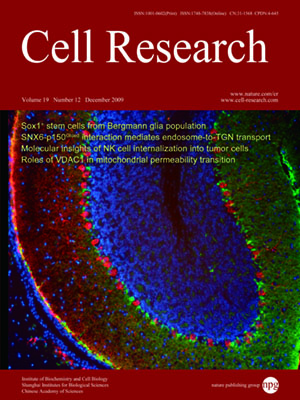
Volume 19, No 12, Dec 2009
ISSN: 1001-0602
EISSN: 1748-7838 2018
impact factor 17.848*
(Clarivate Analytics, 2019)
Volume 19 Issue 12, December 2009: 1350-1362
ORIGINAL ARTICLES
Internalization of NK cells into tumor cells requires ezrin and leads to programmed cell-in-cell death
Shan Wang1,2,*, Zhen Guo3,*, Peng Xia3, Tingting Liu1, Jufang Wang1, Shan Li1, Lihua Sun1, Jianxin Lu2, Qian Wen4, Mingqian Zhou4, Li Ma4, Xia Ding5, Xiaoning Wang1,2,4 and Xuebiao Yao3
1School of Bioscience and Bioengineering, South China University of Technology, Guangzhou 510641, China
2Wenzhou Medical College, Wenzhou 325035, China
3Anhui Key Laboratory for Cellular Dynamics and Chemical Biology, University of Science and Technology of China, Hefei 230027, China
4Nanfang Medical University, Guangzhou 510515, China
5Beijing University of Chinese Medicine, Beijing 100086, China
Correspondence: Xiaoning Wang, Xuebiao Yao,(xnwang@21cn.net; yaoxb@ustc.edu.cn)
Cytotoxic lymphocytes are key players in the orchestration of immune response and elimination of defective cells. We have previously reported that natural killer (NK) cells enter target tumor cells, leading to either target cell death or self-destruction within tumor cells. However, it has remained elusive as to the fate of NK cells after internalization and whether the heterotypic cell-in-cell process is different from that of the homotypic cell-in-cell event recently named entosis. Here, we show that NK cells undergo a cell-in-cell process with the ultimate fate of apoptosis within tumor cells and reveal that the internalization process requires the actin cytoskeletal regulator, ezrin. To visualize how NK cells enter into tumor cells, we carried out real-time dual color imaging analyses of NK cell internalization into tumor cells. Surprisingly, most NK cells commit to programmed cell death after their entry into tumor cells, which is distinctively different from entosis observed in the homotypic cell-in-cell process. The apoptotic cell death of the internalized NK cells was evident by activation of caspase 3 and DNA fragmentation. Furthermore, NK cell death after internalization is attenuated by the caspase inhibitor, Z-VAD-FMK, confirming apoptosis as the mode of NK cell death within tumor cells. To determine protein factors essential for the entry of NK cells into tumor cells, we carried out siRNA-based knockdown analysis and discovered a critical role of ezrin in NK cell internalization. Importantly, PKA-mediated phosphorylation of ezrin promotes the NK cell internalization process. Our findings suggest a novel regulatory mechanism by which ezrin governs NK cell internalization into tumor cells.
Cell Research (2009 )19:1350-1362. doi: 10.1038/cr.2009.114; published online 29 September 2009
FULL TEXT | PDF
Browse 1934


